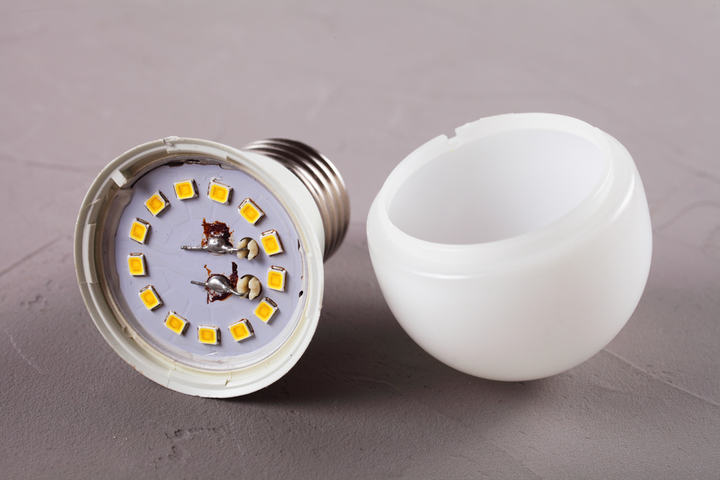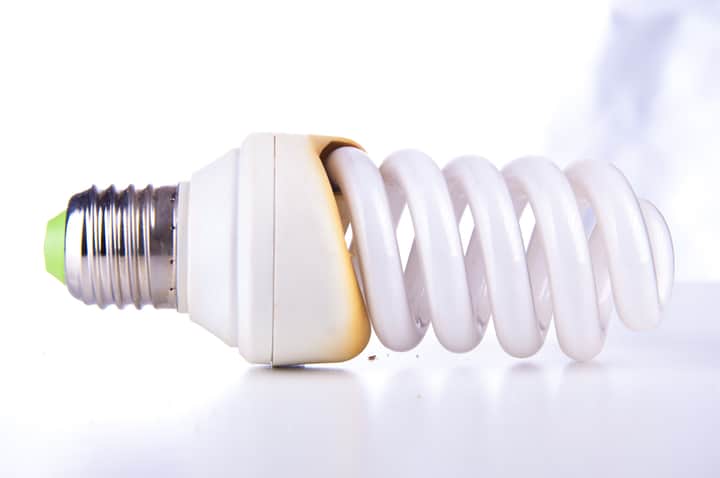Wasting electricity means that you’re throwing away money, and you’re squandering the fuel that was used to generate the electricity in the first place.
Whether your first concern is your wallet or the planet, you’ll want to make sure that you aren’t using electricity in your home needlessly.
So, when you have a blown bulb, how quickly do you need to act? If you leave it alone, you might forget that you’ve left it switched on. Does this mean you’re wasting money and fuel to try to illuminate a bulb that is broken?
LED and fluorescent bulbs still draw a very small current when blown, but incandescent bulbs do not. The amount of electricity drawn by blown fluorescent bulbs can vary up to 50% of full power, but with LEDs, only a trace amount of current is drawn.
In this article I’m going to explain to you:
- Why incandescent bulbs don’t draw power when blown
- Why LED and fluorescent bulbs do draw power when they’re blown
- Whether it’s safer to leave a blown bulb in a socket, or remove it
Do Blown Incandescents Use Electricity?

Let’s start with incandescent bulbs. These use a tungsten filament, which, when heated by electricity, generates light.
When the bulb is blown, the filament is broken – you’ll often be able to see that it looks snapped if you look closely at the bulb itself.
When this happens, the circuit is broken. Think of it as a switch – the filament is now a blocker because it prevents the circuit from being completed.
Of course, a switch breaks the circuit because you choose it to, whereas in this case, the lightbulb breaks it just because the connection is actually broken.
When that happens, it means that there is no way for electricity to pass through the completed circuit, which means there is infinite resistance.
And so, no power will flow through the circuit, so even if you leave the light switch on, you won’t be using electricity.
Considering the short lifespan of incandescent light bulbs – less than 2,000 hours,or the equivalent of one to three years based on average use – and it’s a good thing that incandescent bulbs don’t use power when burned out, as across your home you’re likely to have a burned-out bulb quite often.
But as I’m about to explain, LED bulbs (with their vastly superior rated lifespan of anything up to 50,000 hours) don’t exactly cost the earth if they’re left switched on when blown, and will still always be a better option to save money.
Can LED Bulbs Draw Electricity When Burned Out?

With LEDs, the answer is a little more complicated – and that’s because an LED bulb is a more sophisticated device. It doesn’t merely generate light from heating a filament, but it has multiple parts, including more than one light-emitting diode within a bulb.
The problem here is that with more components involved in creating light, more parts can still draw electricity.
The circuit isn’t physically broken when the light-emitting elements fail. So current is still drawn through the circuit to these other parts.
So, bad news, right? Well, not really. Because a working LED bulb is extremely energy efficient and requires a tiny current to work.
Damaged components don’t then decrease the resistance, so a blown bulb isn’t going to suddenly start costing you more.
In fact, an LED bulb will draw less power – much less, to the point of being negligible. And when I say that, I don’t mean a few cents per hour, which over time could actually add up to a few dollars, which can be important money.
Let’s take a 7.5W bulb at the average kWh rate of 13 cents.
To work out the bulb’s cost, you need to first work out the kilowattage of the bulb – simply divide 7.5 by 1,000 to get 0.0075kWh. Multiply this by 13 cents, and you get the hourly cost of a (working) LED bulb – 0.0975 cents.
So even if you don’t replace a blown LED bulb for 100 hours, it’s going to cost you 1 cent even at full power.
It won’t draw full power, though – it’ll be a trace of that, more likely to be millionths of a cent. So, in summary, a blown LED bulb will technically draw power, but to such a tiny amount that you’ll never notice.
Do Burned Out Fluorescent Bulbs Still Use Electricity?

Compact fluorescent lamps (CFLs) are a sort of middle-ground option for lighting. They’re longer-lasting and more energy-efficient than incandescent bulbs but not as good as LEDs.
However, when it comes to a blown CFL, they’re actually the worst offenders for drawing current. Like an LED, they don’t open the circuit when they blow, so current can still flow through them. And depending on how they are blown, they could draw up to 50% of their full power current.
But it’s worth putting that into context. Even at half-power, a blown CFL bulb will draw around 10W, which means you’re still talking many hours before there’s an impact on your electricity costs.
It’s worth replacing a blown CFL bulb as soon as possible, but it won’t leave you in financial problems if you forget.
Should I Leave The Burned Bulb In A Socket?
If a bulb has blown and you don’t have a spare one ready to replace it with, the safest thing you can do is leave the bulb in the socket.
Don’t remove it and leave the socket empty – that’s an electrocution risk, while it also leaves the circuit open to debris, which could start a fire.
I’ve written about this previously – if you want to know more about why it’s best to leave a dead bulb in the socket, check it out here.
Final Words
When you blow a bulb, you might not have a spare to hand. You might not even notice right away, especially if it’s a spotlight where you have other bulbs still giving plenty of light.
So, it can be easy to accidentally switch on a dead bulb, then forget to switch it off.
It’s not something to worry about, though, because even with an LED or CFL bulb that does still draw power, the amount is so small that you’d have to leave it unattended for days to even start costing yourself just a few cents.
Just remember to keep the blown bulbs in place for safety until you’re able to get a replacement from a store or delivered when you shop online.
Have you had any problems with bulbs burning out too quickly, or maybe you’ve struggled to work out why your electric bill is so high when you’re doing everything you can to conserve energy?
Let me know your common issues in the comments, and I’ll happily help.
Looking for an LED bulb but not sure what type you need?
Check out my free bulb picker and select the right bulb within few clicks.

